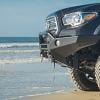Hi Vic and all,
Great info here. I tried to read through some of this but got a bit overwhelmed with the amount of info.
I'm trying to figure out what charging voltage I should put on my MPPT charge controller.
I recently replaced my solar panel (previously 80w) and 2 camper batteries that were dead (I would drop below 11.5V in a single night running the fridge).
My setup:
In California, using camper mostly for weekend trips and but sometimes spending several days in the camper at one location.
Most of the draw comes from the CoolMatic CR-110 2 way Fridge (2.2 Ah/h at +25°C), have LED lights, fantastic fan etc... I also have a 800W inverter hooked to the battery with very thick wires and a 150A circuit breaker. But I only use it to charge cell phones etc...
Toyota Tundra with 55 AH truck battery and 150amp alternator.
Four Wheel Hawk Camper with factory installed solar wiring, IOTA DLS-30 and IQ-4.
Blue Star Solar Boost 2000e MPPT (http://www.blueskyen...l_BSE_SB2KE.pdf)
12v 180w solar panel (new, https://www.solarblv...ne-solar-panel/)
Two 125 AH batteries = 250 AH (new, https://www.vmaxtank...ttery_p_38.html)
Yes, I have read this thread and I know i am supposed to have 1.5x the AH in solar W and I don't.
http://www.blueskyen.../pdf/100214.pdf says
"A rule of thumb for proper battery charging is that there be at least 50 – 60W of PV power producing about 3.0 – 3.5A of charge current per 100 amp-hours of battery capacity. An absolute minimum with little or no loads is about 25W or 1.5 amps of charge current per 100 amp-hours."
So I am hoping I am still OK. My thinking was that the more AH I have, the less I will drain my batteries on weekend trips, as long as I stay within a range that will still make solar charging effective even though my solar panel will not be able to fully charge the batteries on its own. But feel free to criticize my decision here.
The MPPT manual says:
Charge voltage should be set to the battery manufacturers recommendations. The factory setting of 14.0 volts is suitable for most lead-acid chemistry batteries and does not typically require adjustment. For a predominately float application a somewhat lower voltage of 13.8 volts may be beneficial in decreasing water loss. For a heavily cycling application, a somewhat higher voltage of 14.5V may be beneficial in decreasing charge time and increasing amp-hours delivered.
The battery spec says:
Charging Voltage 14.4-14.9V
Charging Current 8A-35A (Do not use a charger with smaller amperage than the recommended Charging Current)
Float Voltage 13.5V-13.8V
Temperature Compensation:
Cycle use: -30mV/C
Standby use: -20mV/C
I have not yet taken the camper out since I replaced the solar panel and batteries so I do not know how it will behave "in the wild".
My immediate question is:
Should I leave the MPPT charge voltage at the factory default 14V, or increase it to 14.5V?
I'm not quite understanding if I'm operating in "charging" or "floating" mode. I'm guessing I should leave it at 14V because I'm not providing the minimum 8A of charging current just from the solar panel.
Other questions:
Should I set the temperature compensation to -30mV/C or -20mV/C? (currently set to -30mV/C, I do not have a battery temperature sensor)
What is the optimal way to keep the camper at home? (I turn off the DC system and keep the camper in the sun, but should I plug it in the house AC or not, given that I have the IQ-4)
Would I benefit by swapping the truck battery with a 120 AH battery?
Any other things I should to to optimize things?
Thanks!
Herve
Edited by Herve, 01 October 2017 - 08:48 PM.














